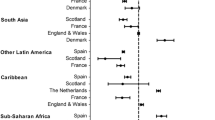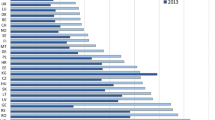Summary
In Turkey, reliable cause-specific mortality data are not available. It is thus unknown whether ischaemic heart disease (as in western Europe and the US) or stroke (as in the Far East) is the prevailing cause of cardiovascular death. This information, however, is required for planning cardiovascular prevention programmes. We analyse available Turkish national cause-of-death data as well as patterns of cardiovascular mortality in a hospital in Ankara and among Turkish migrants in Germany. According to national statistics, the ischaemic heart disease-to-stroke ratio would be 0.3 among men aged 45–64 years, lower than that in Japan. Hospital and migrant data show this ratio to be 2–4. We demonstrate the implausibility of the national data by assessing the precision of cause-of-death assignment. We then discuss to what degree mortality experience among migrants is representative for their country of origin. Our findings suggest that the pattern of cardiovascular mortality in Turkey is closer to that in western Europe and the US than to that in the Far East. Finally, we discuss options for improving cardiovascular surveillance in Turkey.
Zusammenfassung
In der Türkei gibt es keine verlässliche Todesursachenstatistik. Somit ist auch unbekannt, welches die vorherrschende kardiovaskuläre Todesursache ist: ischaemische Herzerkrankung wie in Westeuropa und den USA oder Schlaganfall wie im fernen Osten. Diese Information ist jedoch zur Planung von kardiovaskulären Präventionsprogrammen erforderlich. Wir analysieren daher die vorhandenen nationalen türkischen Mortalitätsdaten sowie das Muster kardiovaskulärer Mortalität in einem Krankenhaus in Ankara und unter türkischen Migranten in Deutschland. Laut nationaler Statistik läge die Verhältniszahl von Herzinfarkt- zu Schlaganfall-Todesfällen bei Männern im Alter von 45–64 Jahre bei 0,3 und damit niedriger als in Japan. Krankenhaus- und Migrantendaten zeigen hingegen eine Verhältniszahl von 2–4. Wir zeigen, dass die nationalen Zahlen aufgrund mangelnder Präzision bei der Todesursachen-Zuschreibung implausibel sind und diskutieren die Übertragbarkeit von Migrantendaten auf das Heimatland. Unsere Ergebnisse legen nahe, dass das Muster der kardiovaskulären Sterblichkeit in der Türkei eher dem in Westeuropa und den USA als dem im fernen Osten ähnelt. Abschliessend diskutieren wir Ansätze für eine verbesserte kardiovaskuläre Surveillance in der Türkei.
Résumé
En Turquie, il n'y a pas de statistiques fiables sur la mortalité par cause spécifique. Ainsi, nous ne connaissons pas non plus la cause principale de mortalité cardiovasculaire: affection cardiaque ischémique (comme en Europe de l'ouest ou aux Etats-Unis) ou attaque d'apoplexie (comme en Extrême-Orient). Toutefois, cette information est nécessaire pour planifier des programmes de prévention cardiovasculaire. C'est pour cette raison que nous analysons les statistiques nationales de mortalité disponibles en Turquie ainsi que la structure de la mortalité cardiovasculaire dans un hôpital d'Ankara et parmi les immigrés turcs en Allemagne. D'après les statistiques nationales, le ratio entre décès suite à une affection cardiaque ischémique et suite à une attaque d'apoplexie chez les hommes de 45 à 64 ans serait de 0,3 et donc plus bas qu'au Japon. Les données obtenues à travers l'hôpital et les immigrés présentent néanmoins un ratio de 2–4. Nous montrons qu'en raison d'une précision insuffisante lors de l'assignation de la cause de mort, les données nationales manquent de plausibilité. Ensuite, nous débattons de la question de savoir si les données obtenues d'immigrés sont représentatives de leur pays d'origine. Nous concluons que la structure de la mortalité cardiovasculaire en Turquie correspond dans une certaine mesure à celle en Europe de l'ouest et aux Etats-Unis et nous faisons des propositions pour montrer comment il est possible d'améliorer la surveillance cardiovasculaire.
Similar content being viewed by others
References
World Health Organization. The World Health Report 1998. Geneva: 1998: 87–88.
Reddy KS, Yusuf S. Emerging epidemic of cardiovascular disease in developing countries. Circulation 1998;97: 596–601.
de Backer G, Laaser U, Wenzel H. Cardiovascular disease surveillance. In: Eylenbosch WJ, ed. Surveillance in Health and Disease. Oxford: Oxford University Press, 1988: 115–124.
Hancioglu A. A demographic assessment of data and information on Turkish mortality. In: Wunsch G, Hancioglu A, eds. Morbidity and Mortality data: Problems of Comparability, Ankara: Hacettepe University, Institute of Population Studies, 1997: 209–233.
Mahley RW, Palaoglu KE, Atak Z, et al. Turkish Heart Study: lipids, lipoproteins, and apolipoproteins. J Lipid Res 1995;36: 839–857.
Venketasubramanian N. Trends in cerebrovascular disease mortality in Singapore: 1970–1994. Int J Epidemiol 1998;27: 15–19.
Garber AM, Browner WS. Guidelines for Using Serum Cholesterol, High-Density Lipoprotein Cholesterol, and Triglyceride Levels as Screening Tests for Preventing Coronary Heart Disease in Adults. Ann Intern Med 1996;124: 515–517.
Tezcan S. Information on morbidity and causes of death in Turkey. In: Wunsch G, Hancioglu A, eds. Morbidity and Mortality Data: Problems of Comparability, Ankara: Hacettepe University, Institute of Population Studies, 1997: 191–207.
Onat A, Senocak MSS, Surdum-Avci G, Örnek E. Prevalence of coronary heart disease in Turkish adults. Int J Cardiol 1993;39: 23–31.
State Institute of Statistics Turkey. Death Statistics (in Province and District Centers). Ankara: 1987–1996 (annually).
Poungvarin N. Stroke in the developing world. Lancet 1998;352: 19–22.
Eastern Stroke and Coronary Heart Disease Collaborative Research Group. Blood pressure, cholesterol, and stroke in eastern Asia. Lancet 1998;352: 1801–1807.
Yuan J-M, Ross RK, Wang X-L, Gao Y-T, Henderson BE, Yu MC. Morbidity and mortality in relation to cigarette smoking in Shanghai, China. JAMA 1996;275: 1646–1650.
Causes of death (methodology). Wrld Hlth Stat Annu 1989; 12–15.
Causes of death: Turkey (reporting areas) 1987. Wrld Hlth Stat Annu 1989;318–321.
Chaturvedi N, McKeigue PM. Methods for epidemiological surveys of ethnic minority groups. J Epidemiol Community Health 1994;48: 107–111.
Marmot MG. Changing places changing risks: The study of migrants. Public Health Rev 1993;21: 185–195.
Razum O, Zeeb H, Gerhardus A. Cardiovascular mortality of Turkish nationals residing in West Germany. Ann Epidemiol 1998;8: 334–341.
Last JM (ed). A Dictionary of Epidemiology. New York, Oxford, Toronto: Oxford University Press, 1995.
Causes of death, by sex and age, USA 1994. Wrld Hlth Stat Annu 1998; B-438-B-441.
Causes of death, by sex and age, Japan 1993. Wrld Hlth Stat Annu 1995; B-338-B-341.
Erzeren Ö. Türkischer Staatspräsident Özal gestorben. Die Tageszeitung 1993; 3987: 8
Kliewer E. Epidemiology of diseases among migrants. International Migration 1992;XXX: 141–164.
Benfante R. Studies of cardiovascular disease and cause-specific mortality trends in Japanese-American men living in Hawaii and risk factor comparisons with other Japanese populations in the Pacific region: a review. Human Biology 1992;64: 791–805.
Syme SL, Marmot MG, Kagan A, Kato H, Rhoads G. Epidemiologic studies of coronary heart disease and stroke in Japanese men living in Japan, Hawaii and California: introduction. Am J Epidemiol 1975;102: 477–480.
Robertson TL, Kato H, Gordon T, et al. Epidemiologic studies of coronary heart disease and stroke in Japanese men living in Japan, Hawaii and California. Coronary heart disease risk factors in Japan and Hawaii. Am J Cardiol 1977;39: 244–249.
Marmot MG, Syme SL. Acculturation and coronary heart disease in Japanese-Americans. Am J Epidemiol 1976;104: 225–247.
Swerdlow AJ. Mortality and cancer incidence in Vietnamese refugees in England and Wales: a followup study. Int J Epidemiol 1991;20: 13–19.
Wild S, Laws A, Fortmann SW, Varady AN, Byrne CD. Mortality from coronary heart disease and stroke for six ethnic groups in California, 1985 to 1990. Ann Epidemiol 1995;5: 432–439.
Shi L. Health care in China: a rural-urban comparison after the socioeconomic reforms. Bull World Health Organ 1993;71: 723–736.
Ministry of Health Turkey. National Health Policy of Turkey. Ankara: 1993.
Razum O, Borchert M, Scheuermann W. Do we need “population monitoring laboratories” to evaluate community-based prevention of cardiovascular disease in developing countries? Trop Med Int Health 1998;3: 251–255.
Author information
Authors and Affiliations
Corresponding author
Additional information
This research was carried out in preparation of an EU-funded project on cardiovascular disease prevention in Turkey and Lebanon, INCO-DC ERB IC 18-CT98-0352.
Rights and permissions
About this article
Cite this article
Razum, O., Akgün, S. & Tezcan, S. Cardiovascular mortality patterns in Turkey: What is the evidence?. Soz Präventivmed 45, 46–51 (2000). https://doi.org/10.1007/BF01358998
Published:
Issue Date:
DOI: https://doi.org/10.1007/BF01358998




